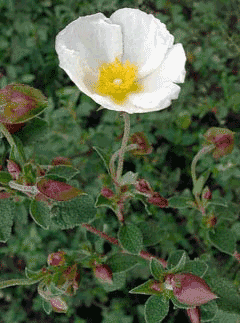 |
|
http://www.legambientearcipelagotoscano.it/ |
 |
|
Translate this page:
Summary
Bloom Color: White.
Main Bloom Time: Late spring. Form: Spreading or horizontal.
Physical Characteristics

 Cistus salviifolius is an evergreen Shrub growing to 0.6 m (2ft) by 0.8 m (2ft 7in) at a fast rate.
Cistus salviifolius is an evergreen Shrub growing to 0.6 m (2ft) by 0.8 m (2ft 7in) at a fast rate.
See above for USDA hardiness. It is hardy to UK zone 8 and is not frost tender. It is in leaf all year, in flower in June, and the seeds ripen in August. The species is hermaphrodite (has both male and female organs) and is pollinated by Bees. The plant is self-fertile.
It is noted for attracting wildlife.
Suitable for: light (sandy) and medium (loamy) soils, prefers well-drained soil and can grow in nutritionally poor soil. Suitable pH: mildly acid, neutral and basic (mildly alkaline) soils. It cannot grow in the shade. It prefers dry or moist soil and can tolerate drought. The plant can tolerate maritime exposure.
UK Hardiness Map
US Hardiness Map
Synonyms
Plant Habitats
Woodland Garden Sunny Edge; Ground Cover;
Edible Uses
Edible Parts:
Edible Uses: Condiment
The dried leaves are used as an adulterant for marjoram (Origanum majorana)[177, 183].
References More on Edible Uses
Medicinal Uses
Plants For A Future can not take any responsibility for any adverse effects from the use of plants. Always seek advice from a professional before using a plant medicinally.
None known
References More on Medicinal Uses
The Bookshop: Edible Plant Books
Our Latest books on Perennial Plants For Food Forests and Permaculture Gardens in paperback or digital formats.

Edible Tropical Plants
Food Forest Plants for Hotter Conditions: 250+ Plants For Tropical Food Forests & Permaculture Gardens.
More

Edible Temperate Plants
Plants for Your Food Forest: 500 Plants for Temperate Food Forests & Permaculture Gardens.
More

More Books
PFAF have eight books available in paperback and digital formats. Browse the shop for more information.
Shop Now
Other Uses
A good ground cover plant for the milder areas of Britain[208]. The form 'Prostratus' has been recommended[197].
Special Uses
Attracts Wildlife Ground cover
References More on Other Uses
Cultivation details
Landscape Uses:Ground cover, Massing. Requires a sunny position in a dry or moist well-drained light sandy soil[11, 182]. Withstands drought once it is established[11, 184]. Tolerates maritime exposure[188]. Plants are hardy to about -12°c, but they require protection in severe winters[11]. Plants are somewhat hardier when grown in poor soils[182]. Individual flowers only last one day but there is a long succession of them[11, 200]. Dislikes pruning or root disturbance[200]. Plants should be pot grown and then planted out in their final positions whilst still small. This species is notably resistant to honey fungus[88, 200]. The flowers are very attractive to bees[108]. Hybridizes freely with other members of this genus[200]. This species is closely related to C. hirsutus[182].
References Carbon Farming Information and Carbon Sequestration Information
Temperature Converter
Type a value in the Celsius field to convert the value to Fahrenheit:
Fahrenheit:
The PFAF Bookshop
Plants For A Future have a number of books available in paperback and digital form. Book titles include Edible Plants, Edible Perennials, Edible Trees,Edible Shrubs, Woodland Gardening, and Temperate Food Forest Plants. Our new book is Food Forest Plants For Hotter Conditions (Tropical and Sub-Tropical).
Shop Now
Plant Propagation
Seed - gather when ripe and store dry[78]. Surface sow in late winter in a greenhouse[164]. The seed usually germinates in 1 - 4 weeks at 20°c[164]. Prick out the seedlings as soon as they are large enough to handle into individual pots. Grow them on in the greenhouse for their first winter and plant them out the in the following spring or early summer, after the last expected frosts[164]. The seed stores for at least 3 years[K]. Cuttings of softish to half-ripe wood, 8cm long with a heel or at a node, June/August in a frame. Roots are formed within 3 weeks[78]. High percentage[78]. Cuttings of almost mature wood, 8 - 12cm with a heel or at a node, September/October in a frame. High percentage[78]. Lift and pot up in the spring, plant out when a good root system has formed[78]. Layering in spring.
Other Names
If available other names are mentioned here
Native Range
TEMPERATE ASIA: Turkey EUROPE: Albania, Bulgaria, Greece (incl. Crete), Italy (incl. Sicily), Spain (incl. Baleares), France (incl. Corsica), Portugal AFRICA: Algeria, Libya, Morocco, Tunisia
Weed Potential
Right plant wrong place. We are currently updating this section.
Please note that a plant may be invasive in one area but may not in your area so it's worth checking.
Conservation Status
IUCN Red List of Threatened Plants Status :

Growth: S = slow M = medium F = fast. Soil: L = light (sandy) M = medium H = heavy (clay). pH: A = acid N = neutral B = basic (alkaline). Shade: F = full shade S = semi-shade N = no shade. Moisture: D = dry M = Moist We = wet Wa = water.
Now available:
Food Forest Plants for Mediterranean Conditions
350+ Perennial Plants For Mediterranean and Drier Food Forests and Permaculture Gardens.
[Paperback and eBook]
This is the third in Plants For A Future's series of plant guides for food forests tailored to
specific climate zones. Following volumes on temperate and tropical ecosystems, this book focuses
on species suited to Mediterranean conditions—regions with hot, dry summers and cool, wet winters,
often facing the added challenge of climate change.
Read More
Expert comment
Author
L.
Botanical References
1189200
Links / References
For a list of references used on this page please go here
Readers comment
© 2010, Plants For A Future. Plants For A Future is a charitable company limited by guarantee, registered in England and Wales. Charity No. 1057719, Company No. 3204567.